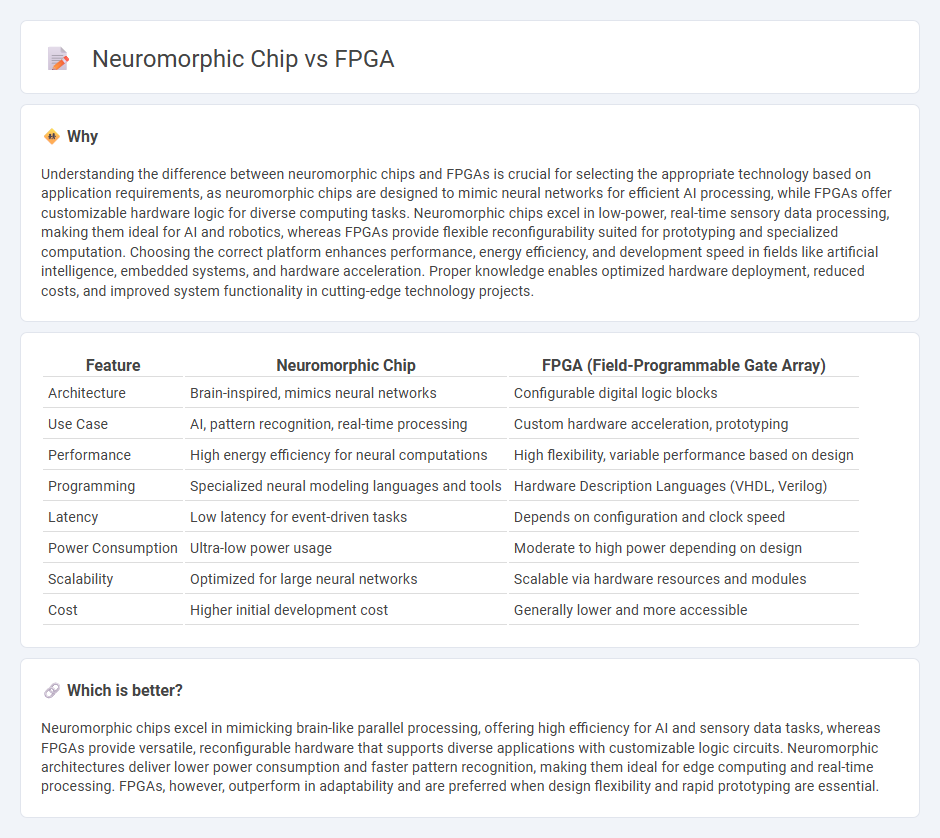
Neuromorphic chips emulate the human brain's neural architecture to enable advanced cognitive computing with high energy efficiency and real-time data processing. Field Programmable Gate Arrays (FPGAs) offer reconfigurable hardware flexibility, allowing rapid adaptation for diverse computational tasks with low latency. Explore how neuromorphic chips and FPGAs compare in transforming next-generation technology applications.
Why it is important
Understanding the difference between neuromorphic chips and FPGAs is crucial for selecting the appropriate technology based on application requirements, as neuromorphic chips are designed to mimic neural networks for efficient AI processing, while FPGAs offer customizable hardware logic for diverse computing tasks. Neuromorphic chips excel in low-power, real-time sensory data processing, making them ideal for AI and robotics, whereas FPGAs provide flexible reconfigurability suited for prototyping and specialized computation. Choosing the correct platform enhances performance, energy efficiency, and development speed in fields like artificial intelligence, embedded systems, and hardware acceleration. Proper knowledge enables optimized hardware deployment, reduced costs, and improved system functionality in cutting-edge technology projects.
Comparison Table
| Feature | Neuromorphic Chip | FPGA (Field-Programmable Gate Array) |
|---|---|---|
| Architecture | Brain-inspired, mimics neural networks | Configurable digital logic blocks |
| Use Case | AI, pattern recognition, real-time processing | Custom hardware acceleration, prototyping |
| Performance | High energy efficiency for neural computations | High flexibility, variable performance based on design |
| Programming | Specialized neural modeling languages and tools | Hardware Description Languages (VHDL, Verilog) |
| Latency | Low latency for event-driven tasks | Depends on configuration and clock speed |
| Power Consumption | Ultra-low power usage | Moderate to high power depending on design |
| Scalability | Optimized for large neural networks | Scalable via hardware resources and modules |
| Cost | Higher initial development cost | Generally lower and more accessible |
Which is better?
Neuromorphic chips excel in mimicking brain-like parallel processing, offering high efficiency for AI and sensory data tasks, whereas FPGAs provide versatile, reconfigurable hardware that supports diverse applications with customizable logic circuits. Neuromorphic architectures deliver lower power consumption and faster pattern recognition, making them ideal for edge computing and real-time processing. FPGAs, however, outperform in adaptability and are preferred when design flexibility and rapid prototyping are essential.
Connection
Neuromorphic chips emulate the neural architecture of the human brain to enhance AI processing efficiency, while FPGAs (Field-Programmable Gate Arrays) provide customizable hardware platforms ideal for implementing and testing neuromorphic algorithms. FPGAs enable rapid prototyping and optimization of neuromorphic circuits by offering reconfigurable logic gates, which accelerates the development of brain-inspired computing systems. The synergy between neuromorphic chips and FPGAs drives advancements in low-power, high-speed artificial intelligence applications.
Key Terms
Parallel Processing
FPGA (Field-Programmable Gate Array) offers customizable hardware-level parallelism, enabling concurrent execution of multiple tasks with high flexibility for diverse applications. Neuromorphic chips mimic brain-like neural architectures to efficiently process information through massively parallel, event-driven computations that excel in pattern recognition and sensory data processing. Explore deeper insights into the comparative advantages of FPGA and neuromorphic chips in advanced parallel processing scenarios.
Reconfigurability
FPGA devices excel in reconfigurability by allowing hardware-level customization through programmable logic blocks, enabling rapid adaptation to various neural network architectures and applications. Neuromorphic chips, while efficient in mimicking brain-like structures, offer limited reconfigurability, primarily optimized for specific spiking neural network models. Explore detailed comparisons to understand which platform suits your adaptive computing needs best.
Spiking Neural Networks
FPGAs offer customizable, parallel processing architectures ideal for implementing Spiking Neural Networks (SNNs) with real-time adaptability and precise control over neural parameters. Neuromorphic chips are specifically engineered to mimic biological neural processes, enabling highly energy-efficient, low-latency SNN computations through specialized hardware components like memristors and event-driven communication. Explore the comparative advantages of FPGA and neuromorphic platforms to optimize your next SNN application.
Source and External Links
Field-programmable gate array - Wikipedia - Field-programmable gate arrays (FPGAs) are configurable integrated circuits that can be programmed after manufacturing, widely used in research, development, and various industries for their flexibility and processing speed.
What is an FPGA - Lattice Semiconductor - FPGAs are integrated circuits that enable rapid prototyping and system design through their programmable fabric, ideal for applications like edge computing, AI, and system security.
What is a field programmable gate array (FPGA)? - IBM - FPGAs are versatile integrated circuits designed for programmability, offering high performance and real-time flexibility, making them suitable for telecommunications, automotive, and aerospace industries.
 dowidth.com
dowidth.com